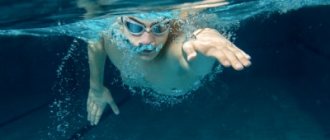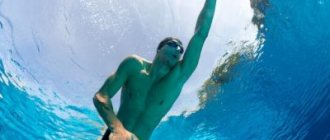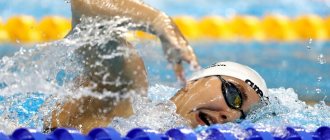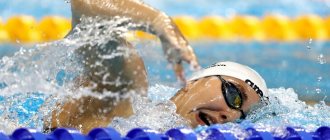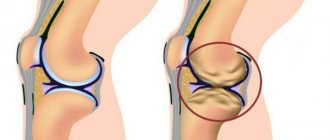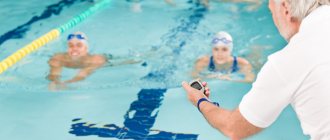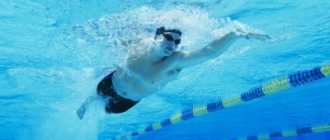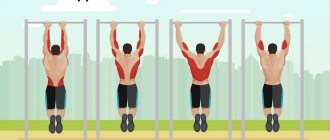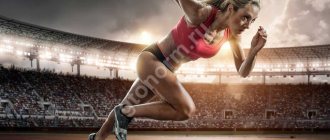How to increase your swimming speed
In order to increase your speed in freestyle swimming at any distance (from 100 meters to several kilometers), you need to go through three stages :
- Firstly , you need to develop good swimming technique. This is the very first and most important stage, without which all further efforts will be meaningless. We talk in detail about the correct crawl technique in this article.
- Secondly, you need to be in good physical shape, which in this case includes aerobic endurance and strong muscles responsible for crawl swimming.
Aerobic endurance is achieved through regular training in the pool – it is recommended to do three (or at least two) sessions a week, in which you work for at least 20 minutes at a heart rate in the range of 50-80 percent of the “MHR minus your age” value.At the same time, remember that the heart needs to be protected and increased loads can lead to irreversible changes in it - if you are interested in this issue in more detail, watch this video:
Muscular endurance is also developed through training, both in water and during exercise on land.
- Thirdly , after you have completed the first two points (correct technique and good physical shape), your further development as a swimmer will sooner or later stop and then a logical question will arise - what to do next to swim faster?
The answer to this is working on mistakes and improving technique .
Recommendations for beginner freestyle swimmers
People who want to master this style on their own will need some useful tips. It is advisable to swim without straining your neck muscles. You need to move smoothly, easily, without straining. Turning your head to inhale should be done immediately to the left and right sides. The rate of movement of the lower extremities under water increases gradually. When swimming on your chest, when throwing your arm forward, your whole body must rush behind your shoulder. When swimming on your back, it is better to keep your hips below the shoulder line by about 30 degrees.
Before swimming lessons, it is recommended to do a warm-up in the gym to invigorate your muscles and improve stretching.
Identifying errors: why is there no speed?
Your next step is to identify errors and shortcomings in your technique.
Here, first of all, it should be noted that it is extremely difficult to identify mistakes in yourself - you don’t see yourself from the outside, and when you swim, it seems that you are doing everything more or less correctly.
This problem has the following solutions :
- Ask your coach to look at your technique and identify errors and shortcomings.
If there is an opportunity (including financial), you can even get the opinion of several people - this way you will be able to collect more recommendations and advice. It is also better to correct defects under the supervision of a specialist. - Take a video of your swimming and at least look at yourself from the outside, or even better, again, contact a specialist. Look for such a service on swimming school websites - you can send your video and receive its analysis remotely.
Next, we will consider the main points that are most often associated with shortcomings in technology.
Learn to coordinate movements not only in the pool
In freestyle it is important to maintain coordination of movements and the ability to control the body. You need to count the strokes and strokes to yourself, be able to “turn on” and “turn off” muscle groups. Also, at the same time, assess the situation around you and not stray from the course.
If you were involved in sports clubs as a child, it will be easier to master the crawl. Adults can go to dancing, yoga, fitness classes accompanied by music: they also teach movement coordination and body control.
Fitness dancing helps improve coordination of movements
After the crawl technique has been mastered and practiced, you can prepare for a swim in big water.
How to swim faster using your body position
At the initial training stage, all attention is paid to the work of the arms, legs and breathing - this is understandable, because the above is the basis for the crawl.
However, when the basics are mastered, it is worth paying great attention to how our body is positioned in the water.
From a swimming perspective, the basic rules of hydrodynamics are as follows:
- the more streamlined the body, the less it slows down on the water;
- the longer the body, the better it glides through the water.
Horizontal body position is the basis of crawl swimming.
If your body is not elongated enough, not horizontal enough, then due to this your speed is significantly reduced.
Therefore, the objectives of the training are to achieve maximum extension of the body and its correct horizontal position in the water.
How to learn to maintain body balance correctly
It is necessary to achieve as horizontal a position as possible, not due to the fact that the legs are pushing from behind, but due to the fact that the body itself is so located in the water.
To do this, we need to remember that our chest is an air sac that determines the balance of the body, and the bottom will always sink , because the legs do not contain air.
Forces that prevent you from taking a horizontal position
Imagine that your body is rigid and your chest is lying on a round log. In this case, you need to press (shift your weight) on the very front of your chest to take a horizontal position.
Head position
The head should be parallel to the bottom of the pool , the spine should be a straight line from the dorsal region to the cervical region.
look below you all the time - you will not be able to do this if you raise your head.
When we lean on our chest, we also lean on our face, and the face should be relaxed.
This is explained very well in this short video:
Pulling and sliding
Try to push off from the side of the pool with your feet with your arms outstretched and try to slide for as long as possible , to feel the balance of your body.
This exercise can be repeated 5-10 times at the beginning of the workout and at the end.
Breath
The swimmer's movement will be correct only with proper breathing.
The main characteristic of breathing when swimming crawl is rhythm.
Inhalation is carried out through the mouth while turning the head to the side, towards the rowing hand (this creates a so-called air pocket). Then the face is lowered into the water, where exhalation occurs (first through the mouth, then through the nose).
The number of breaths on each side should be the same, since it is in this case that the rotation of the body will be correct, which will ensure a high speed of movement.
It is best to inhale every 3rd or 5th stroke with your arms. This way you will practice turning your head in both directions. But when learning to swim crawl, it is permissible to take air every second stroke - the main thing is to alternate (one pool of breathing on the left, the second on the right).
When taking air from the right side:
- The left arm is extended forward.
- The right one is extended back along the body, while the right shoulder begins to move out of the water.
- The head turns to the right side, the gaze looks back - inhale.
Same for the left side.
Improving leg technique
Rhythmic footwork and balance
Crawl is a swimming style that requires your legs to work non-stop and rhythmically - think of it like your engine is always on.
Although we should try to maintain as horizontal a position as possible even without legs, the reality is that ultimately it is the legs that keep us horizontal and maintain the balance of the body.
Therefore, it is definitely recommended to develop their rhythmic work down to a subconscious level - this is done by swimming with a board , when we move only using our legs, ideally we should inhale every sixth stroke.
It is recommended to swim with a board at least 200 meters in one set.
It is useful to combine swimming with and without fins.
Watch the second minute of this video, there is a good commentary on footwork technique:
As you inhale, pay attention: if you begin to put pressure on the swimming board with your hands, this should not happen!
Also pay attention to the fact that the work always comes from the hips and the feet are extended.
Leg-Hand Coordination
Ideally, when the hand enters the water, the opposite leg makes a kick . Thanks to this, the leg helps rotate the body on its side, maintains body balance, and promotes better gliding.
For the two-beat freestyle this is generally the basis of the technique (read about it here), but for the regular six-beat freestyle it is also recommended.
IMPORTANT: For whom is the COURSE absolutely not suitable?
Are there any restrictions on this COURSE? Who is it absolutely not suitable for? Yes. There are restrictions. And this is the fear of water. Panic fear of taking a step into the unknown - to where there is “no bottom.” This sometimes happens to adults - especially if there was a negative experience in the water in early childhood. Is it possible to overcome this fear? It's certainly possible. Is it difficult? No, easy enough. But attention - you need to start with individual work with a good coach. Which will help you carefully take this “first step” into the water.
Well, after that, you are welcome to our COURSE.
There are no more obstacles and restrictions!
I want to learn to swim crawl...
How to improve your hand technique
Bend angle using video example
First you need to hook the water and make a stroke with the brush perpendicular to the water.
This is shown perfectly here at the beginning of the video, and other errors are also shown there:
As you can see, if the arm is not bent enough , the result is a small angle and a poor stroke .
Position for better water capture
Placement in water: not in the center
The hand should be placed in the water parallel to the line of movement - then the stroke will be more effective and the glide will be better.
Imagine that our body is divided along its axis by an insurmountable wall. Then the right hand can only work in the right zone , and the left , accordingly, only in the left ; they work parallel to each other and cannot enter the center.
Rotation of the body to help the arms
Make sure your body rotates - roll from one side to the other during the strokes.
This allows for a longer and stronger stroke.
Body rotations are shown in slow motion video here:
Want to evaluate the course before purchasing? Please!
You can get the first lessons of the course for 490 rubles.
You also get access to a closed chat with them, where Alexey Likhobabin publishes chapters of his new book “Crawl, easy speed. How to swim your first kilometer crawl and not get tired"
Pay for demo course
Well, if you have no doubts and you value your time, open access to the full version of the course right now.
Click here to pay for the course...
If you have any difficulties placing or paying for your order, please contact us by email
or by phone, WhatsApp, Telegram Yuri
You will receive any advice regarding your order.
If you don’t want to deal with the registration and payment procedures, I will help you. Write or call me at the contacts above.
Workout
The best way to determine the intensity of your workout is to measure your heart rate immediately after the swim. In 6 seconds you can calculate its frequency. Add 0 to the resulting figure - this will be the result in a minute. If the training is designed for 10 weeks, each element is worked out for 1 week. Then there is a transition to the next one, repeating the previous one. Then, over 10 weeks, your base will be gradually developed, reaching the point of automation.
Breathing technique
Endurance depends on it. During swimming, the athlete's face is immersed in water, the upper level is along the forehead.
Sequencing:
- moving your arm forward with your shoulder;
- turning the body in the opposite direction;
- sharp breath through the mouth.
As the face emerges from the water, the ear should be pressed to the leading shoulder. Looking towards the opposite limb going under the water. Inhalation is done every third stroke with the hand, then breathing on the right and left alternates.
The head turns smoothly, the body is only horizontal, with rotations along the axis to the right and left. Forward movement occurs due to forward movements of the shoulders.
Hand movements
In the crawl technique, one hand goes into the water, palm down , elbow slightly bent. It describes a semicircle underwater, straightens up and comes out near the swimmer's side. At the same time, the second hand is thrown forward and repeats the action of the previous one.
The movement technique in this case is reminiscent of pulling your hands out of your back jeans pocket. The little finger in the hand should be at its highest point. The lead shoulder then lifts slightly out of the pool and the body turns onto its side.
Typical mistakes:
- hand tension;
- raising the hand above the elbow.
Leg movements
The lower limbs have little effect on speed. But they are needed for balance and horizontality of the body in the water. First, the knee is bent, then the leg is swung (as in kicking a ball) and the leg is straightened. The second leg immediately picks up and performs a similar cycle.
Typical mistakes:
- strong bend and swing;
- the leg does not come out of the water.
Strength training
Strength in the crawl technique will increase as you move forward underwater. To maximize it, the muscles must be trained - the abs, back and upper shoulder girdle. Overloading these muscles will impair technique.
You can develop strength using swimming blades ; they should take up to 50% of your training time. Choose them correctly - they should be straight, slightly larger than your arm.
A kolobaska can also help - it doesn’t “clog” your shoulders compared to your shoulder blades, and you can swim more and longer with it. The kolobaska will pump up both strength and endurance.
Power training:
- Warm-up and cool-down: 10 times 25 m - 1 fast, 1 calm.
- Main part: 40x50 with training shoulder blades and bun, pauses of 10 seconds.
Speed
To increase speed:
- 500 m - warm-up;
- 8x50m - exercises, that is, working on something that doesn’t work well;
- 4x50m - acceleration. At each segment you should gradually increase the load;
- 5x100m - coordinated swimming, the first 100m is calm, another 100m with a little effort, the third with an even effort, the next - race pace, the last - a little faster.
- 200 m - cool down.
Endurance
To train endurance you need aerobic swimming. If you swim 3 times a week, one workout should be dedicated to aerobic exercise.
Tempo endurance:
- 16x25 - every 4th swim is fast;
- 12x25 - every 3rd is fast;
- 8×25 – every 2nd is fast;
- 4×25 - all fast, pause 20 seconds between series.
